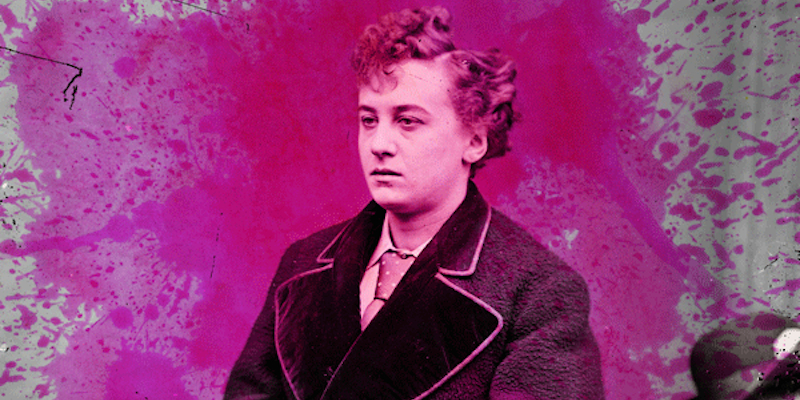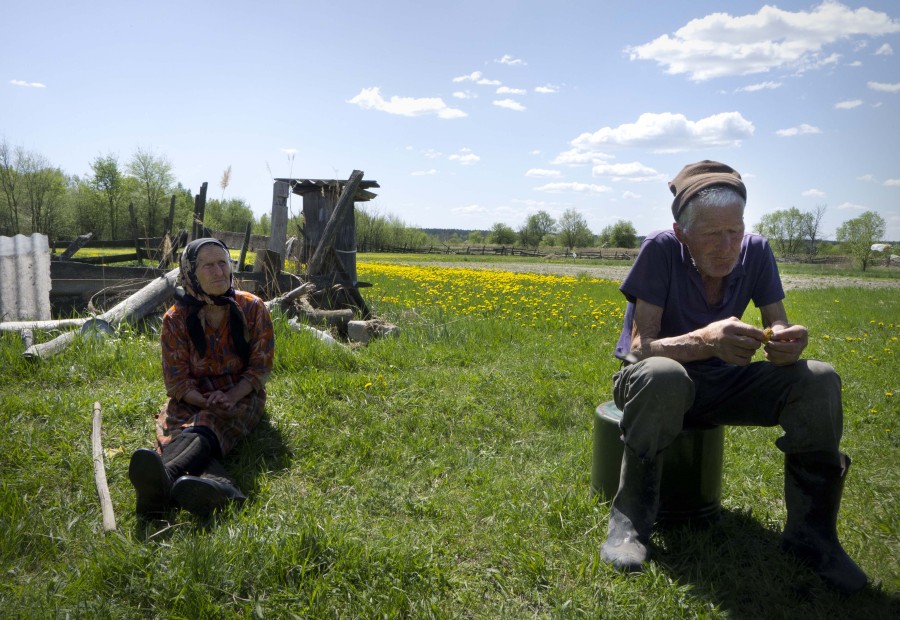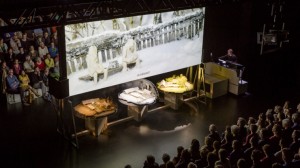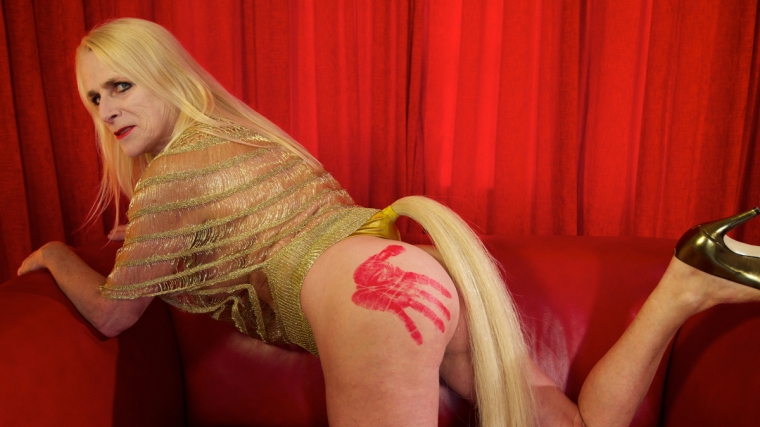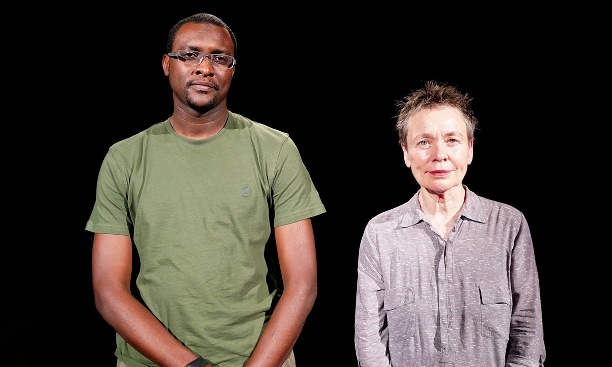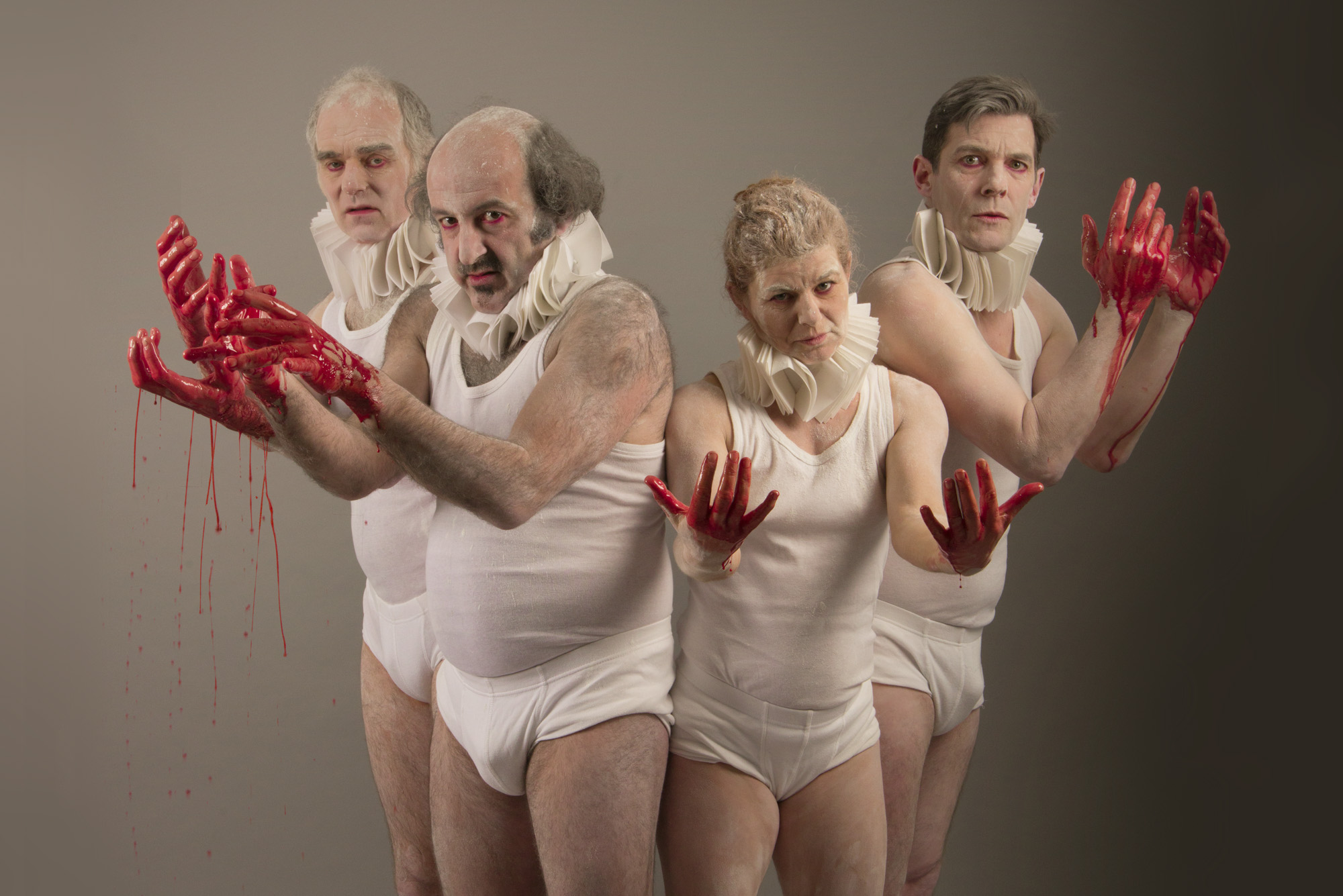Who is Stella? What is she?
Let’s start (as we should) with the show itself; with what Neil Bartlett chooses to give us.
A man, stage left, our right, sitting on a chair in front of the glorious red velvet curtains of the Theatre Royal. A man in black, sitting perfectly still. He stands, he places a hand under the curtain, and the curtain rises, as if by his magical command, Who is this man? Servant? Master? Magician? Funeral director?
We see a stage within the stage; a kind of large podium. A man (a different one) sits on a chair. This man is middle-aged, besuited and anxious. The stage is black and bare, except for two chairs, a light bulb on a long flex, and a row of lights at the back, off centre, that look like an exaggerated take on those light bulbs you get around the mirrors in dressing rooms.
Ah, mirrors! Mirrors are important to this production. We are told by the anxious sitting man that there are no mirrors here – all the mirrors are covered. We hear the crash of breaking glass, and a narrative as fragmented as a shattered mirror emerges. Waiting for a cab at 7pm. A hand smashing into the glass. A mirror covered with a cloth.
Another person enters. He. She. Ze. They. Take your pick – we live in an age when (although things aren’t perfect) there is at least an option for choosing the pronoun by which you’d like to be known. This person is Stella. Stella has bare legs and arms, and masculine shoulders. Stella has a lovely round and pretty face, fluffy blonde hair, a feminine voice. Stella is wearing a silk gown that is a sort of kimono. She sits, and as she talks, she takes out a hand-held mirror and does her make-up. It’s her birthday. She’s waiting to be collected. She has a lover called Arthur who is not that handsome and a bit nervous and sweaty – but he is rich. Her mother approves. This story is set a hundred years before Marilyn will sing Diamonds Are a Girl’s Best Friend, but her spirit is channelled here. The light reflected from the mirror in her hand bounces around the stage and auditorium, a fast-moving butterfly fluttering hither and thither.
The two characters on the podium chairs – one constant as young Stella, the other vacillating between a number of voices: the scared aristocratic lover Arthur, who disappears when Stella is arrested; an older Stella reflecting on the past; and Stella’s alter-ego / birth persona Ernest Boulton. Often, the two actors are delivering monologues cleverly intercut so that there are echoes of words and feelings picked up on by the other. Occasionally there is dialogue. Circling around them is the man we first met raising the curtain. In the programme credits he is called The Attendant. He watches. He witnesses. He sometimes brings things to Stella – a pair of shoes, a tray of cosmetics.
Neil Bartlett gives us Stella’s personal story, a specific individual tale of liberation, oppression, and fighting to be seen as who you choose to be, set in the 19th century; yet this is also a kind of playfully anachronistic leap in and out of other times – with the thoughts and words of famous contemporary experimenters with gender and image, including Bette Bourne and Scottee, allowed to inform the script. Yes, things are different now. But we’ve still a way to go.
All three actors are brilliant in their roles. Richard Cant brings age and experience to the stage. He speaks quietly, forcing you to really listen to him. Oscar Batterman, who graduated from Guildhall School of Music and Drama only last year, is a perfect choice for young Stella. He captures the delicate balance between brash boyish exuberance and girlish coquettishness that Stella plays out, and with, so effectively. David Carr is ideal as the attendant – an efficient and subservient butler, yet somehow also the puppet-master in the background.
I have a conversation with myself about the decision to cast a black actor in this ‘servant’ role. Is it racist of me even to notice? Is there a sub-text about there being other issues of identity and liberation from oppression that will also need to be played out in the 19th and 20th centuries, alongside issues of gender? I think about scrapping this paragraph from this review – but I’ve kept it in, in the interests of honesty, because even now, in the liberated 21st century, when we see bodies on stage, we note that they are ‘male’ or ‘female’ or ‘young’ or ‘old’ or ‘black’ or ‘white’. We do not see neutral bodies. Will we ever?
Stella is written and directed by Neil Bartlett. And if there is one thing you can say about Bartlett, it’s that he knows his stuff. His productions vary wildly in style and form, but what they have in common is the care and precision with which everything is done. Nothing unnecessary is left in. Everything onstage – words, physical action, visual tableaux, lights, sounds – is beautifully executed. He’s never afraid to use stillness, to take his time. A lesson in contemporary dramaturgy.
I think it is fair to say that this is a production where the programme notes are a useful addition to understanding the context of the play. Best read afterwards, of course – but having some information on Ernest Boulton’s biography is helpful to enhance and inform the experience witnessed onstage. But this is extra: the show is complete in itself.
What we are presented with is a story of a shattered life, in which the beautiful Stella, although a victim, shines out brilliantly and soars above her troubles, be they arrest and harassment, abandonment by scared lovers, or the far more mundane but just as nasty experience of losing your good looks as you age, and having to reappraise who you are, and reinvent yourself continuously. There is also the less glamorous but equally interesting story of Arthur, and the choices he makes. His ‘cowardice’ – if we can call it that – as he abandons Stella in her hour of need is hardly to be condemned in the circumstances. He, like Stella, is a victim of oppression.
Wouldn’t it be dreadful if this were a real story, we are asked, onstage numerous times, and in the programme notes. Well, it is…
It is dreadful that such things happened. Heartbreaking. It is also an honour to witness the stories of those who fought the battles that paved the way for the changes in society that our generation is benefitting from. More work to be done, but great leaps have been made – we stand on Stella’s shoulders. A heroine for our times.

